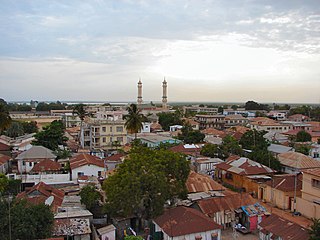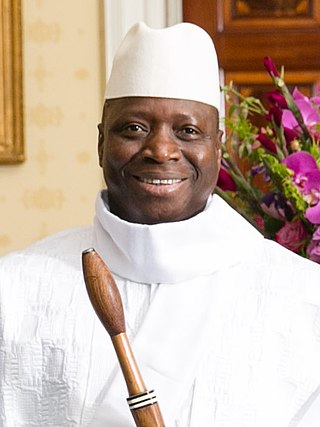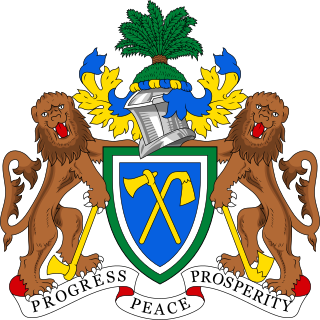Twenty-first century
| History | |||||
|---|---|---|---|---|---|
| Geography | |||||
| Politics | |||||
| Economy | |||||
| Society |
| ||||
Years in Africa | |
|---|---|
| Sovereign states |
|
States with limited recognition | |
Dependencies and other territories |
|
This is a timeline of History of the Gambia . Each article deals with events in The Gambia in a given year.

The Gambia, officially the Republic of The Gambia and Gambia, is a country in West Africa. Geographically, Gambia is the smallest country in continental Africa; it is surrounded by Senegal, except for its western coast on the Atlantic Ocean. It is situated on both sides of the lower reaches of the Gambia River, which flows through the centre of the country and empties into the Atlantic Ocean. The national namesake river demarcates the elongated shape of the country, which has an area of 11,300 square kilometres (4,400 sq mi) and a population of 2,468,569 people in 2024. The capital city is Banjul, which has the most extensive metropolitan area in the country; the second- and third-largest cities are Serekunda and Brikama.

Banjul, officially the City of Banjul, is the capital and fourth largest city of The Gambia. It is the centre of the eponymous administrative division which is home to an estimated 400,000 residents, making it The Gambia's largest and most densely populated metropolitan area. Banjul is on St Mary's Island, where the Gambia River enters the Atlantic Ocean.

The first written records of the region come from Arab traders in the 9th and 10th centuries. In medieval times, the region was dominated by the Trans-Saharan trade and was ruled by the Mali Empire. In the 16th century, the region came to be ruled by the Songhai Empire. The first Europeans to visit the Gambia River were the Portuguese in the 15th century, in 1447, who attempted to settle on the river banks, but no settlement of significant size was established. Descendants of the Portuguese settlers remained until the 18th century. In the late 16th century, English merchants attempted to begin a trade with the Gambia, reporting that it was "a river of secret trade and riches concealed by the Portuguese."

The Gambia Armed Forces, also known as the Armed Forces of The Gambia, consists of three branches: the Gambia National Army (GNA), the Gambia Navy, and the Republican National Guard (RNG). It formerly included the Gambia National Gendarmerie (GNG) from the 1980s to 1996, when they were moved under the jurisdiction of the Ministry of the Interior. The commander-in-chief is the president of the Gambia who is currently Adama Barrow, whereas practical control is exercised by the Chief of the Defence Staff who is currently Lieutenant General Yankuba Drammeh.

The Gambia River is a major river in West Africa, running 1,120 kilometres (700 mi) from the Fouta Djallon plateau in north Guinea westward through Senegal and The Gambia to the Atlantic Ocean at the city of Banjul. It is navigable for about half that length.

The president of the Republic of The Gambia is the head of state and head of government of the Gambia. The president leads the executive branch of the government of the Gambia and is the commander-in-chief of the Gambia Armed Forces. The post was created in 1970, when the Gambia became a republic and has been held by three people: Dawda Jawara, who ruled from 1970 until 1994, Yahya Jammeh, who seized power in a bloodless coup that year and Adama Barrow, who defeated Jammeh in elections held in December 2016.

Yahya Abdul-Aziz Jemus Junkung Jammeh is a Gambian politician and former military officer, who served as President of the Gambia from 1996 to 2017, as well as Chairman of the Armed Forces Provisional Ruling Council from 1994 to 1996.

The flag of The Gambia is the national flag of The Gambia. It consists of three horizontal red, blue and green bands separated by two thin white lines. Adopted in 1965 to replace the British Blue Ensign defaced with the arms of the Gambia Colony and Protectorate, it has been the flag of the Republic of the Gambia since the country gained independence that year. It remained unchanged throughout the Gambia's seven-year confederation with Senegal.

Senegambia, officially the Senegambia Confederation or Confederation of Senegambia, was a loose confederation in the late 20th century between the West African countries of Senegal and its neighbour the Gambia, which is almost completely surrounded by Senegal. The confederation was founded on 1 February 1982 following an agreement between the two countries signed on 12 December 1981. It was intended to promote cooperation between the two countries, but was dissolved by Senegal on 30 September 1989 after the Gambia refused to move closer toward union. The Senegambia Confederation should not be confused with the historic Senegambia region, generally shortened to the Senegambia.

The Gambia national football team represents The Gambia in men's international football and is controlled by the Gambia Football Federation. Until 1965, the team and the country were known as British Gambia. The team has never qualified for the World Cup. In 2021, Gambia qualified for the Africa Cup of Nations finals for the first time in history. The team represents both FIFA and Confederation of African Football (CAF).

The Gambia Football Federation (GFF), formerly known as the Gambia Football Association, is the governing body of football in Gambia. It was founded in 1952, and affiliated to FIFA in 1968 and to CAF in 1966. It organizes the GFA League First Division, the GFA League Second Division and the national team. The current president is Lamin Kaba Bajo since September 2014.
The Gambian hip hop scene is a relatively new scene in African hip hop which developed in the mid-1990s and was heavily influenced by American hip hop and Senegalese hip hop. Gambian hip-hop has been heavily influenced by international music scene including worldbeat, Senegalese wolof music, and American hip hop, as well as traditional Gambian mbalax and n'daga music. Dominican merengue and Jamaican reggae, ragga, and dancehall have also influenced the development of Gambian hip-hop.

The Gambia Colony and Protectorate was the British colonial administration of The Gambia from 1821 to 1965, part of the British Empire in the New Imperialism era. The colony was the immediate area surrounding Bathurst, and the protectorate was the inland territory situated around the Gambia River, which was declared in 1894.

Elizabeth II was Queen of The Gambia from 1965 to 1970, when the Gambia was an independent sovereign state and a constitutional monarchy within the Commonwealth of Nations. She was also the monarch of the other Commonwealth realms, including the United Kingdom. Her constitutional roles in the Gambia were delegated to the governor-general.

Visitors to the Gambia must obtain a visa from one of the Gambian diplomatic missions, unless they come from one of the visa exempt countries.
The Miss Gambia is a national beauty pageant in The Gambia. The pageant aims to be a cultural ambassador of The Gambia.

Adama Barrow is a Gambian politician and real estate developer who has served as President of the Gambia since 2017.

A constitutional crisis occurred in Gambia following presidential elections in December 2016, in which challenger Adama Barrow achieved an upset victory over longtime incumbent Yahya Jammeh. It eventually concluded after a military intervention by the Economic Community of West African States (ECOWAS) led to Jammeh’s departure from the country.
The COVID-19 pandemic in The Gambia was a part of the worldwide pandemic of coronavirus disease 2019 caused by severe acute respiratory syndrome coronavirus 2. The virus was confirmed to have reached The Gambia in March 2020.
The Gambian Creole people, or Krio or Aku, are a minority ethnic group of Gambia with connections to and roots from the Sierra Leone Creole people. In Gambia the Aku account for about 2% of the population. Some estimates put the figure higher. However, according to the 2013 Gambian Census, the Aku make up 0.5% of the population or around 8,477 people.